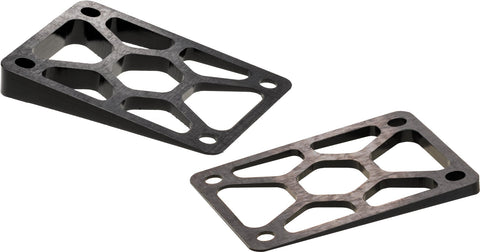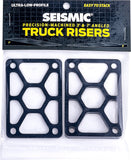Precision-Machined • Ultra-Low Profile • Easy to Stack!
Package of one (1) 3-degree Riser and one (1) 7-degree Riser.
Packaged in pairs of one (1) 3-degree Riser and one (1) 7-degree Riser, with an advanced feature set never before seen in combination…
• Thin ends reduced to 0.5mm-thickness for lowest-possible profile.
• Mounting hole dimensions highly optimized for easy stacking. No more bent bolts from riser hole misalignment!*
• Biomimetic “honeycomb” structure maximizes support with minimal material.
• CNC-machined from tough composite with superior dimensional stability. Highly resistant to deformation from extreme loads and impacts.
How to use Angled Truck Risers (aka Wedges) –
• For quicker steering response, orient the thin end of the Wedge towards the end of the deck. Usually called “wedging,” this is most commonly done with the front truck. Just note that wedging decreases your leverage on the suspension parts (bushings or springs), so you might want to loosen them or even switch to softer ones.
• For slower steering response, orient the thick end of the Wedge towards the end of the deck. Usually called “de-wedging,” this is most commonly done with the rear truck, especially on racing boards. Just note that de-wedging increases your leverage on the suspension parts (bushings or springs), so you might want to tighten them or even switch to stiffer ones.
• Wedging your trucks usually has a small effect on wheelbase length – generally not more than a small fraction of an inch. The exact change depends upon truck axle height; and angle, number, and orientation of the Wedges.
* Maximum recommended stacking is three (3) 7-degree Risers under a single truck. Always orient Risers with the tall end at a right angle to the Deck bottom – this keeps Riser holes aligned parallel to Deck and Baseplate holes. Seismic cannot guarantee against bolt bending caused by poor bolt quality, off-spec baseplate or deck holes, and/or improper fastening (too tight or too loose).




